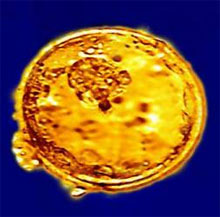Improving IVF
New noninvasive techniques to select embryos for in vitro fertilization (IVF) could boost pregnancy rates and lower the number of risky multiple births. Scientists are using proteomics and metabolomics to screen the liquid that embryos are grown in prior to implantation in order to search for telltale signs of a healthy–or unhealthy–embryo. Some screening tools could be commercially available within the next year.

“Current methods for selecting embryos are far from sensitive or specific enough,” says David Adamson, president of the American Society for Reproductive Medicine.
Embryos created for IVF are typically selected for implantation based on their morphology, or how they look. But this process is notoriously inaccurate: an embryo can look perfectly normal but still fail to implant in the uterine lining–the first step in a successful pregnancy.
While success rates vary, experts predict that about two-thirds of healthy-looking embryos that are transferred into the uterus fail to implant. Women undergo an average of three rounds of IVF before achieving a successful pregnancy, and each round costs approximately $10,000 to $15,000.
Multiple embryos are typically used in each round to increase the chance of success. But this approach can lead to complications. “One of the biggest problems with assisted reproduction and IVF–even as we have gotten better–is multiple births,” says Marcelle Cedars, director of the Division of Reproductive Endocrinology and Infertility at the University of California, San Francisco. “Because of our inability to select an embryo that has the capacity to make a baby, we transfer more embryos, particularly as women get older.” Multiple births can lead to premature delivery, putting babies’ health at risk.
While scientists don’t know exactly why so many embryos fail, genetic abnormalities are likely a major culprit. Fertility specialists have had some success using genetic testing to pick embryos–they can screen for a number of genetic diseases–but this testing requires plucking a cell from the developing embryo, which is potentially risky. Also, the tests can only detect a limited number of known genetic defects.
Now scientists are looking for signs of health status in the nutrient-laden liquid that houses and nourishes embryos for the first few days after creation. By analyzing the proteins and small molecule metabolites secreted into the growth medium, they hope to find the molecular signature of a healthy embryo.
At the University of California, San Francisco, Cedars and her colleagues are studying cases in which only one or two embryos were transferred; they’re comparing molecular signatures of cases that led to successful implantation with those that did not. Using nuclear magnetic resonance imaging to detect specific metabolites and a specialized version of mass spectrometry to identify proteins, the researchers hope to isolatetwo or three key predictive markers. They would then use these markers in a prospective clinical trial to determine if they truly improved pregnancy rates.
However, because nuclear magnetic resonance imaging and mass spectrometry are too expensive and complex to perform routinely in fertility labs,Cedars says that she and her colleagues would then need to develop a quick and simple test for commercial use.
Scientists at Molecular Biometrics, a biotech startup in Chester, NJ, are taking a different approach. They use near-infrared spectroscopy to detect specific molecules involved in oxidative stress, which can be an indicator of health in some tissues. Rather than look at single markers, the researchers have developed a specialized algorithm that can detect differences in the molecular profiles of viable and nonviable embryos.
In an ongoing clinical trial, the company is testing the algorithm’s ability to reliably predict the outcomes of 1,500 patients who received a single embryo transfer. So far, researchers have analyzed about half of the cases. According to James Posillico, president and CEO of Molecular Biometrics, comparing selection based on morphology (the standard selection method) with his company’s metabolomics test showed that the new test is more accurate.
Posillico and his colleagues plan to meet with the U.S. Food and Drug Administration (FDA) next month to finalize details of the clinical trial and to determine if its outcome will provide enough evidence to lead to the approval of the test. “We are looking to enter the international market, including Japan and Australia, by the end of this year or the beginning of next year,” says Posillico. “In the U.S., we hope to have FDA approval by this time next year.”
If previous screening methods are any indication, it might be difficult to determine just how helpful these kinds of tests are. Fertility experts disagree about whether aneuploidy screening–a genetic test to look for chromosomal abnormalities, performed largely on older women–actually improves rates of successful pregnancies. Clinical studies of this test have yielded mixed results.
If the tests prove successful, scientists say that these approaches might eventually do more than aid in the selection of embryos: they might actually show scientists how to fix damaged ones. “You could have therapeutic interventions to help embryos implant,” says Posillico. “Or perhaps put back missing proteins that cause embryos to go bad.”
Keep Reading
Most Popular
Large language models can do jaw-dropping things. But nobody knows exactly why.
And that's a problem. Figuring it out is one of the biggest scientific puzzles of our time and a crucial step towards controlling more powerful future models.
The problem with plug-in hybrids? Their drivers.
Plug-in hybrids are often sold as a transition to EVs, but new data from Europe shows we’re still underestimating the emissions they produce.
Google DeepMind’s new generative model makes Super Mario–like games from scratch
Genie learns how to control games by watching hours and hours of video. It could help train next-gen robots too.
How scientists traced a mysterious covid case back to six toilets
When wastewater surveillance turns into a hunt for a single infected individual, the ethics get tricky.
Stay connected
Get the latest updates from
MIT Technology Review
Discover special offers, top stories, upcoming events, and more.